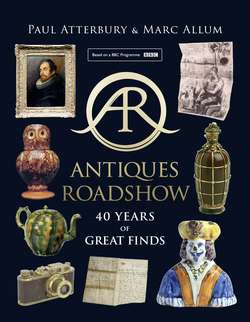Читать книгу Antiques Roadshow: 40 Years of Great Finds - Paul Atterbury, Paul Atterbury - Страница 7
A WILLIAM BURGES BOTTLE
Оглавление‘I was very lucky to be able to film something so important at a relatively early stage in my Roadshow career. It is still one of the best things I have ever seen.’
Paul Atterbury
Near the end of a busy day in October 1996 at the Embassy Centre in Skegness, Lincolnshire, Paul Atterbury had taken a break from his table to have a cup of tea in the Centre’s restaurant. As he sat down, one of the show’s receptionists came over to him clutching a shopping basket in which lay a silver-mounted bottle. For Paul, it was a moment of magic, as he knew at once that he was looking at a long-lost treasure designed by the great Victorian architect, William Burges.
Paul rushed back to the hall to show the bottle to his friend, colleague and fellow Victorian enthusiast David Battie, and they agreed at once that it had to be filmed. Schedules, which at that point in the day were full as usual, were rearranged and, unusually, it was agreed that Paul and David should film it together, in conversation with the owner.
WILLIAM BURGES
A bizarre and eccentric figure, William Burges (1827–1881), was one of the greatest architect/designers of the latter part of the Victorian period. Drawing inspiration from many sources – including High Gothic and Tudor styles, French illuminated manuscripts, the Middle East and various worlds of myth and fantasy – Burges created extraordinary buildings and interiors, along with furniture, metalwork, jewellery and wallpapers. His great friend and major client was John Crichton-Stuart, the 3rd Marquess of Bute, and then one of the richest men in Britain, for whom he created Castell Coch near Cardiff, and extravagantly rebuilt Cardiff Castle. Burges was a consummate colourist and his legacy is a Victorian vision of magnificent splendour and richness.
Burges is known to have designed a wide range of decorative objects in silver and other metals, mostly for his own use at his extraordinary house in Melbury Road, West London, which was full of such treasures. Many are now lost, though they were recorded in a series of photographs taken in the 1880s and mounted in an album that is now in the Victoria & Albert Museum in London.
Paul and David were able to establish quite quickly that this bottle was one of those lost pieces, not seen for over a hundred years. The bottle itself, only about seven inches high, is eighteenth century Chinese porcelain with a coffee-coloured glaze, in itself not exceptional but made so by Burges’ mounts – organic tendrils in jewel-mounted gilded silver – that encase it. The cover is crowned with a pearl-set spider and Burges’ name and the date, 1864, are carried on a band of enamel around the base. In Europe, the tradition of enriching Chinese porcelain with jewelled mounts goes back to the Elizabethan era, an historical reference typical of Burges.
Hugh Scully, David Battie and Paul Atterbury after filming the William Burges bottle.
AN EXTRAORDINARY FIND
During the filming, the lady owner was asked about the background to the bottle. All she knew was that her father, a travelling salesman, had bought it in about 1950 from an antique shop somewhere along the Great North Road. She explained that her father, who had an extraordinary eye and great curiosity, often came home with strange things that he had found on his travels. She remembered that the bottle was one of the most unusual things he found and that he had paid £100 for it, which at the time had seemed a huge amount of money. Having recovered from her shock at the cost, she had forgotten about it, only finding it again after her father’s death.
She revealed that she had never looked at it in detail and had not seen the signature on the enamel band. When it was pointed out to her, she said it meant nothing to her as she had never heard of Burges. Bringing it to the Roadshow had been a last-minute decision, and she said she had very nearly not bothered to come.
AN AUCTION-STYLE VALUATION
Paul and David did the valuation in the form of an auction, taking it in turns to bid until the price reached £30,000. The owner was amazed, but said immediately that it was going back in the sideboard where it lived. Since then, it has never been seen again. Attempts to trace the owner and the bottle during the preparation of this book were unsuccessful. It has not appeared on the market, although similar metalwork by Burges has been sold. It would be a tragedy if this great treasure, lost for a century before its brief Roadshow appearance, is now lost again.
Paul still remembers the sense of excitement and discovery when he first saw the bottle lying in the shopping basket. ‘I have always loved Victorian design, particularly exceptional things like this. Burges was a genius, staggeringly original in his ideas and his craft. Great metalwork by him so rarely comes onto the market. We have had one other major Burges piece in forty years of the Roadshow, a brooch that Geoffrey Munn found. I still feel exactly the same about the bottle, it will always be a highlight of my Roadshow life. It was a classic case of being in the right place at the right time. And sharing it with David was a treat, I think we both knew we were very lucky.’
Today, the William Burges bottle is probably worth £60,000.
